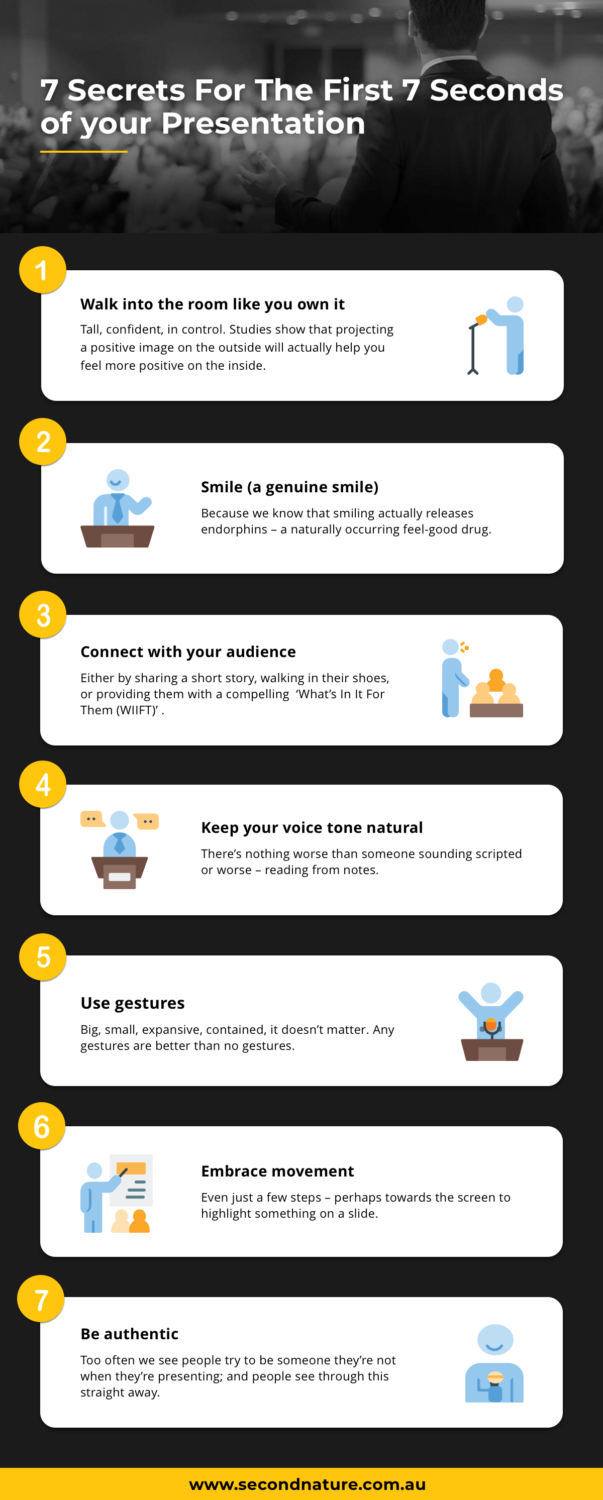In this Article...quick links
- How to calm nerves before a presentation
- How to calm nerves during a presentation (by harnessing your nervous energy!)
- A few more tips on how to calm nerves before a presentation
- And finally – self-help – why not explore yourself how to calm nerves before a presentation
- Improve your presentation skills further!
Here’s some simple and practical tips, not only on how to calm nerves before a presentation but also during a presentation, shared by our Managing Director, Belinda Huckle.
Surveys have shown time and again that the fear of public speaking (scientifically known as glossophobia) is the number one phobia amongst adults. So, if you suffer from pre-presentation nerves, fear, anxiety or stage fright, you are not alone!
There’s more good news too – nerves can actually be a very useful emotion to harness when presenting, as the adrenalin associated with them can actually help us stay sharp and focused. However, left unchecked, nerves don’t help anyone, and can leave us feeling anxious, overwhelmed, inadequate and exhausted.
We have put together some practical, straightforward approaches to help you to begin to understand presentation anxiety and how to manage it.
The key to controlling nerves around presenting involves:
- How to calm nerves before a presentation so they don’t undermine your confidence, and;
- How to calm nerves during a presentation (by harnessing your nervous energy!) to elevate your presentation impact.
So, let’s look at these in some more detail:
How to calm nerves before a presentation
If you do feel nervous in the lead up to a presentation, please, don’t panic. The fact that you are nervous shows that you care both about yourself and your audience. Indeed, if you didn’t have any nerves it could be a sign of complacency or even arrogance.
So, when you feel those tell-tale signs such as butterflies in your stomach, take a step back and try to understand why you are nervous.
Here are three common causes of pre-presentation nerves:
1. Under-preparation
We’d love to tell you that there’s a silver bullet solution to this issue. But there isn’t – it’s up to you to plan, prepare and execute your presentation professionally, just as you would with other aspects and responsibilities of your role. However, we can point you in the right direction! You need to do three main things:
- Firstly, think about your audience – get inside their heads and analyse what they want, and/or what the audience needs to hear from you. The more you can tailor your content so that it’s meaningful and relevant for your listeners, the more interesting and persuasive your presentation will be.
- Secondly, structure your presentation so it builds a clear, logical and compelling narrative that gets your message across in a concise and memorable way. (SecondNature has a fantastic Presentation MapperTM methodology that helps presenters do just that).
- Finally, rehearse and practise – more than once – and definitely out loud (and even record yourself – just set up a dummy meeting on Zoom or Teams) so you’re fully comfortable with your messaging, how it flows, and the time your presentation takes.
- A super-fast technique if you really do not have any time to properly practise, is to memorise the opening – just the first 10 seconds or so – it will take a lot of pressure off you if this is ingrained into your brain in advance and you start strong!
- And, if you’ve got a little more time, you should then memorise the key 3-5 take-aways/messages from your presentation, and your closing sentence. Remember, the occasion for dress rehearsals is not when you have your audience in front of you!
2. A tendency towards perfectionism
If after having prepared and rehearsed you still feel anxious about delivering your presentation, it could be because you are a perfectionist, and so are setting impossibly high standards for yourself and putting yourself under excessive self-generated pressure.
If you suspect you are a perfectionist, acknowledging it is an important first step. You can then use one of the following four tools to attempt to address your perfectionist thinking (at least just for your upcoming presentation!):
- Realistic thinking – Nobody’s perfect! Be honest with yourself. Tell yourself that no one is perfect and tell yourself that making a mistake does not mean you’re a failure or stupid or unprofessional. Just commit to yourself that you will do your best.
- Perspective taking – Try to view situations as other people might see them, by asking yourself how might someone else view the thought of giving your presentation. Is there another perspective? Are there other ways to look at it. Or, turn it around, and ask what might you tell a friend who is having the same nervous thoughts.
- Look at the big picture – Don’t get bogged down in the detail and don’t sweat the small stuff. Ask yourself questions like: “How much does this really matter in the scheme of things?”, “What’s the worst that can happen?”, or “Will this matter tomorrow?”.
- Compromising – Don’t see things as black and white, i.e. that they are either perfect or a disaster. Accept that a presentation that is good can actually be ok. This will help to lower your high standards (this is not suggesting you ditch any standards, just set more realistic ones). Your perfectionism is a little like a phobia of making mistakes. So you could try changing your behaviour using a technique to combat phobias, called Exposure, to gradually introduce yourself to being just slightly less than perfect in important situations…and surviving. Also, if you procrastinate, you can try to overcome it (procrastination is sometimes associated with perfectionism), by setting realistic schedules and priorities.
3. Believing the audience is going to be there only to criticise
Think about it – is that really the case? We very much doubt it. In fact, we would like to think that just about every audience wants the speaker to do well – they are there to listen to a presentation about something that affects them or that they are interested in.
So, accept the audience’s support (explicit or tacit), and let it boost your confidence. You might even involve the audience in your presentation – something we always recommend, whenever possible.
So, perhaps when you’re wondering how to calm nerves before a presentation, or you’re just trying to understand and manage your nerves better, remember the words Benjamin Franklin originally said, “If you fail to plan, you’re planning to fail!”.
Photo: Flickr – Freddie Peña
How to calm nerves during a presentation (by harnessing your nervous energy!)
During your presentation, there are some proven strategies that will help you to harness the excess adrenalin you might have racing around. This excess adrenalin is caused by our Fight or Flight response which in turn can cause sweaty palms, increased heart rate, blushing, the shakes, tightness of breath, wobbly voice, needing to go to the bathroom and so on.
We’ve all heard the expression “You don’t get a second chance to create a positive first impression.” Well, research backs this up. In fact, a recent study by Science of People found that people watching TED talk videos made decisions about how smart, charismatic and credible the speakers were within just 7 seconds.
So, here are 7 secrets for the first 7 seconds of your presentation that show you how to calm nerves during a presentation and will help you to harness your nervous energy and create a powerful first impression.
-
Walk into the room like you own it
– Tall, confident, in control. Studies show that projecting a positive image on the outside will actually help you feel more positive on the inside. Use your body language to your advantage; even if you’re presenting virtually body language is important.
-
Smile (a genuine smile)
– Because we know that smiling actually releases endorphins – a naturally occurring feel-good drug that helps to calm nerves. What’s not to like about that?
-
Connect with your audience
– Either by sharing a short story, walking in their shoes, or providing them with a compelling ‘What’s In It For Them (WIIFT)’ i.e. what they are going to get from your presentation.
-
Keep your voice tone natural and conversational
– There’s nothing worse than someone sounding scripted (or reading from notes). Instead, use your natural speaking voice with plenty of variation in tone, pitch and volume. Vocal variety has also been shown to correlate with higher charisma and credibility ratings from listeners.
-
Use gestures
– Big, small, expansive, contained, it doesn’t matter. Any gestures are better than no gestures. They will help add impact to your message as well as to your delivery style.
-
Embrace movement
– Even just a few steps, perhaps towards the screen to highlight something on a slide; or perhaps a step towards the audience as you introduce yourself; even a small step to the side of a lectern will do. Any movement will grab the audience’s attention as well as break up any build-up of negative energy you may feel. Movement will also make you appear more confident and in control (as long as it’s not fidgeting or rocking). Not only that, but it also instantaneously increases your presence.
-
Be authentic
– Too often we see people try to be someone they’re not when they’re presenting; and people see through this straight away. Be true to your natural style and allow your unique personality to shine through early in the presentation. This will not only help you feel at ease but it will also put the audience at ease.
So, remember, the more you look like you’re enjoying delivering the presentation, the more the audience will enjoy listening to you.
A few more tips on how to calm nerves before a presentation
Imagine success (visualisation)
Many people significantly benefit from imagining themselves successfully delivering their presentations. This is a tool used by world class athletes, musicians and actors. It’s called visualisation. Here’s how to do it:
First, relax; close your eyes and breathe deeply. When you are aware you’re feeling relaxed, imagine yourself, as clearly as you can, successfully delivering your presentation from the beginning to the very end. Imagine walking into the room – tall, confident, calm. Imagine the start of the presentation, focus on the audience and their smiles (and you smiling back); hear your voice, strong and in control. Imagine the smooth transition between slides; the impact of your key messages.
Imagine being able to answer questions with confidence; imagine enjoying talking with the audience and imagine them enjoying listening to you. Imagine your natural personality coming out. Imagine the end; the conviction as you deliver your closing message (or as we call it at SecondNature, your final destination) to your audience; the feeling of pride and satisfaction in your performance. And, remind yourself again and again that the audience wants you to succeed.
For the full effect, this technique should be done a number of times (3-5 is common) in the days leading up to your presentation.
Take a pause
If you feel nerves coming on during your presentation…pause… A real pause, of a few seconds – it may feel like a long time to you, but we promise, it won’t feel like that for the audience. This will help you to regain control and we absolutely guarantee the audience won’t think it’s a negative. In fact, many of the most charismatic and brilliant speakers pause often, for quite a few seconds, during their speeches, in order to add impact, authority and drama. And it is easy to do if you move at the same time.
As part of pausing, an extra option is to also check-in with your audience, e.g. pause…and then ask them if they have any questions about what you’ve shared so far. This is a terrific way to buy yourself time to take a deep breath, gather your thoughts, and to collect yourself.
And, of course, you can always take a sip of water, as a means of pausing. It’s another way to give yourself a few moments to compose yourself again. There’s no rule to say you can’t present and drink at the same time!
Practise, practise, practise
Finally, learning to calm your nerves and present with confidence is like anything – it takes practise, so seize as many presenting opportunities as you possibly can. The more you present, the easier it will get. With time and practise you will find that you will be able to manage your nerves more easily before a presentation and any negative nervous energy during a business meeting or presentation will reduce.
And finally – self-help – why not explore yourself how to calm nerves before a presentation
To learn more about managing your nerves and to keep them in check, why not do some further research and take a deep dive into some physiology, psychology and general physical and mental health. It is interesting to note that negative thoughts often subside once they’re heard and countered with balancing, logical thoughts, so it is possible to use our intellect to override our instincts!
So why not check out things like:
- Your inner dialogue (fears, doubts, uncertainty)
- Your limbic system (which regulates your emotions like stress and anxiety)
- Cognitive reappraisal, Cognitive Behavioural Therapy or Acceptance and Dedication Therapy.
- Your vagus nerve (and exercises to stimulate it to help you relax and de-stress).
- Imposter syndrome.
Then go on to learn some techniques to calm both your breathing and your heart rate. Structured breathing and other breathing techniques like diaphragmatic breathing can be used to help dissipate nerves and therefore help you stay calm.
And, in the end, don’t forget, experiencing nerves before and during a presentation isn’t a bad thing. They show that you care. So prepare and practise, and then be ready to enjoy the opportunity to connect, share, inform, influence, or inspire your audience!
—
Improve your presentation skills further!
Keen to learn how to successfully present with confidence? Then look at tailored training to lift your in-person and online presenting skills.
For nearly 20 years we have been the Business Presentation Skills Experts, training & coaching thousands of people in an A-Z of global blue-chip organisations – check out what they say about our programs.
To find out more, click on one of the buttons below:

Belinda is the Co-Founder and Managing Director of SecondNature International. With a determination to drive a paradigm shift in the delivery of presentation skills training both In-Person and Online, she is a strong advocate of a more personal and sustainable presentation skills training methodology.
Belinda believes that people don’t have to change who they are to be the presenter they want to be. So she developed a coaching approach that harnesses people’s unique personality to build their own authentic presentation style and personal brand.
She has helped to transform the presentation skills of people around the world in an A-Z of organisations including Amazon, BBC, Brother, BT, CocaCola, DHL, EE, ESRI, IpsosMORI, Heineken, MARS Inc., Moody’s, Moonpig, Nationwide, Pfizer, Publicis Groupe, Roche, Savills, Triumph and Walmart – to name just a few.




